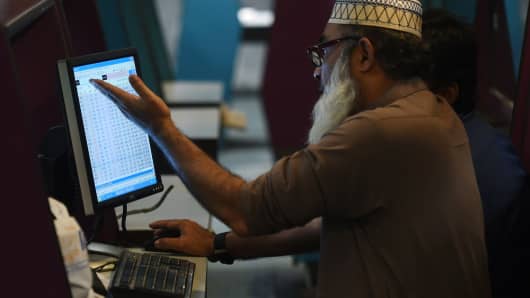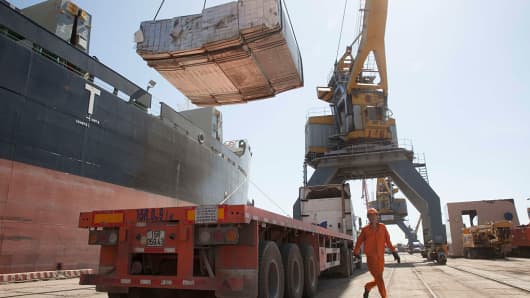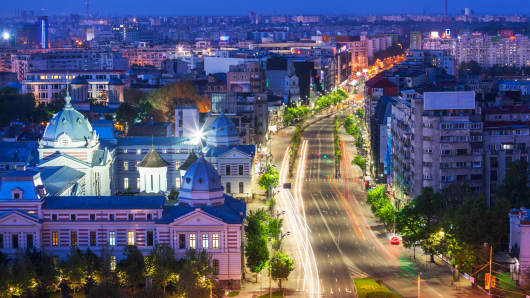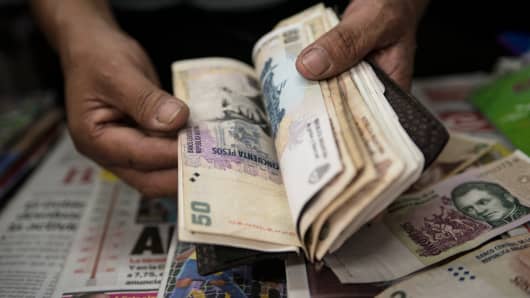Latest topics
After the BRICs, it's time to focus on the VARPs
Page 1 of 1
 After the BRICs, it's time to focus on the VARPs
After the BRICs, it's time to focus on the VARPs
After the BRICs, it's time to focus on the VARPs
Tim Love, Investment Director for Emerging Market Equities, GAM
Friday, 2 Dec 2016 | 4:54 AM ETCNBC.com
Emerging market equities were mostly wrong-footed by the US presidential election result. If President-elect Donald Trump follows through on his pledge to scrap certain trade and regulatory agreements, free trade and emerging markets could suffer.
In this highly uncertain environment, it's key to focus on the emerging economies' domestic drivers which will shape this so-called new world order.
Since the BRICs acronym was coined over a decade ago, it has gripped investors and news headlines alike. But with the traditionally perceived growth engines of Russia and Brazil in the midst of various phases of recession, as well as fundamental policy overhaul taking place in China, investors need to find pockets of opportunity in other frontier markets: Time to introduce VARP.
VARP – Vietnam, Argentina, Romania and Pakistan – represents a collection of geographies, languages, histories and business cultures with one thing in common: they each offer major growth opportunities. The VARP economies are characterized by strong economic growth, all within the 3 percent-6 percent range, with a young demographic of workers keen to spend money.

Asif Hassan | AFP | Getty Images
Pakistani stock brokers watch the latest share prices during a trading session at the Pakistan Stock Exchange in Karachi on September 29.
Pakistani stocks have soared this year following an announcement from the MSCI that its equities will be included in the emerging markets index.
Improving credit ratings on the back of healthy economic growth, more manageable inflation and the government's efforts towards fiscal consolidation have heightened investor interest in Pakistan. The country is also benefiting from numerous infrastructure projects under development as part of the $46 billion China-Pakistan Economic Corridor.

Chau Doan | Light Rocket | Getty Images
Hai Phong port in Hai Phong, Vietnam on July 1, 2015.
Similar to Pakistan, Vietnam's close proximity to China has meant its economy has also benefited from China's infrastructure roll-out program, making it an attractive investment destination.
Vietnam's economy expanded at an annual rate of 6.4 percent in the third quarter of 2016, buoyed by rising foreign direct investment and exports – the country is the top producer of robusta coffee, used to make instant coffee. Manufacturing also gathered pace.
Additionally, Vietnam's fast growing middle class means that its appetite for buying protein items such as milk is soaring as the population becomes increasingly health-conscious. As a result, we see the country's dairy sector as an interesting investment space.

Walter Bibikow | Getty Images
Bucharest, Romania
In the past two decades Romania has come out of economic turmoil and morphed into a destination for foreign direct investments, including European Regional Development Funds.
Representing a typical 'convergence play' into the European Union, Romania is perceived as a less risky investment as it assimilates into the economic fundamentals and values of Europe.

Leo La Valle | AFP | Getty Images
Argentine peso bills
For more than a decade, Argentina was cut off from international capital markets after the peso was massively devalued, leaving its economy brittle and with a plethora of international debts to settle. But the current pro-business government is aiming to restore Argentina's global reputation as an investment destination through various overhauls of the public sector and economic administration of the country.
Argentina's President Mauricio Macri has already attempted to overhaul the country's electricity sector – he continues to push for the removal of subsidies to allow electricity companies to charge for energy at rates closer to the cost of production. We believe that once the country manages to iron out its issues of recession and currency volatility, its banking and electricity sectors could be poised to strongly benefit.
VARP equity markets are becoming increasingly liquid and accessible to investors. While Argentina is currently benefitting from a tax amnesty on capital repatriation and is in the process of removing capital controls, Vietnam, Romania and Pakistan are easy to access locally through cash or derivatives.
To be sure, these economies face risks: Vietnam and Pakistan are dependent on the speed of Chinese developments; a stronger US dollar may hurt Argentina's commodity-based exports, and a slower EU integration would affect Romania. However, these individual risks are unlikely to materialise simultaneously given their low correlation to each other.
The VARP economies are over 13 times smaller than BRICs and therefore we do not expect them to help drive the global economy in the same way, or to generate the same levels of returns for investors. However, these frontier markets add a deeper dimension to an emerging markets portfolio with potential attractive risk returns – because of their diversity.
http://www.cnbc.com/2016/12/02/after-the-brics-its-time-to-focus-on-the-varps.html
Tim Love, Investment Director for Emerging Market Equities, GAM
Friday, 2 Dec 2016 | 4:54 AM ETCNBC.com
Emerging market equities were mostly wrong-footed by the US presidential election result. If President-elect Donald Trump follows through on his pledge to scrap certain trade and regulatory agreements, free trade and emerging markets could suffer.
In this highly uncertain environment, it's key to focus on the emerging economies' domestic drivers which will shape this so-called new world order.
Since the BRICs acronym was coined over a decade ago, it has gripped investors and news headlines alike. But with the traditionally perceived growth engines of Russia and Brazil in the midst of various phases of recession, as well as fundamental policy overhaul taking place in China, investors need to find pockets of opportunity in other frontier markets: Time to introduce VARP.
VARP – Vietnam, Argentina, Romania and Pakistan – represents a collection of geographies, languages, histories and business cultures with one thing in common: they each offer major growth opportunities. The VARP economies are characterized by strong economic growth, all within the 3 percent-6 percent range, with a young demographic of workers keen to spend money.
Pakistan

Asif Hassan | AFP | Getty Images
Pakistani stock brokers watch the latest share prices during a trading session at the Pakistan Stock Exchange in Karachi on September 29.
Pakistani stocks have soared this year following an announcement from the MSCI that its equities will be included in the emerging markets index.
Improving credit ratings on the back of healthy economic growth, more manageable inflation and the government's efforts towards fiscal consolidation have heightened investor interest in Pakistan. The country is also benefiting from numerous infrastructure projects under development as part of the $46 billion China-Pakistan Economic Corridor.
Vietnam

Chau Doan | Light Rocket | Getty Images
Hai Phong port in Hai Phong, Vietnam on July 1, 2015.
Similar to Pakistan, Vietnam's close proximity to China has meant its economy has also benefited from China's infrastructure roll-out program, making it an attractive investment destination.
Vietnam's economy expanded at an annual rate of 6.4 percent in the third quarter of 2016, buoyed by rising foreign direct investment and exports – the country is the top producer of robusta coffee, used to make instant coffee. Manufacturing also gathered pace.
Additionally, Vietnam's fast growing middle class means that its appetite for buying protein items such as milk is soaring as the population becomes increasingly health-conscious. As a result, we see the country's dairy sector as an interesting investment space.
Romania

Walter Bibikow | Getty Images
Bucharest, Romania
In the past two decades Romania has come out of economic turmoil and morphed into a destination for foreign direct investments, including European Regional Development Funds.
Representing a typical 'convergence play' into the European Union, Romania is perceived as a less risky investment as it assimilates into the economic fundamentals and values of Europe.
And finally...Argentina

Leo La Valle | AFP | Getty Images
Argentine peso bills
For more than a decade, Argentina was cut off from international capital markets after the peso was massively devalued, leaving its economy brittle and with a plethora of international debts to settle. But the current pro-business government is aiming to restore Argentina's global reputation as an investment destination through various overhauls of the public sector and economic administration of the country.
Argentina's President Mauricio Macri has already attempted to overhaul the country's electricity sector – he continues to push for the removal of subsidies to allow electricity companies to charge for energy at rates closer to the cost of production. We believe that once the country manages to iron out its issues of recession and currency volatility, its banking and electricity sectors could be poised to strongly benefit.
VARP equity markets are becoming increasingly liquid and accessible to investors. While Argentina is currently benefitting from a tax amnesty on capital repatriation and is in the process of removing capital controls, Vietnam, Romania and Pakistan are easy to access locally through cash or derivatives.
To be sure, these economies face risks: Vietnam and Pakistan are dependent on the speed of Chinese developments; a stronger US dollar may hurt Argentina's commodity-based exports, and a slower EU integration would affect Romania. However, these individual risks are unlikely to materialise simultaneously given their low correlation to each other.
The VARP economies are over 13 times smaller than BRICs and therefore we do not expect them to help drive the global economy in the same way, or to generate the same levels of returns for investors. However, these frontier markets add a deeper dimension to an emerging markets portfolio with potential attractive risk returns – because of their diversity.
http://www.cnbc.com/2016/12/02/after-the-brics-its-time-to-focus-on-the-varps.html
*****************

>>>TNTBS's YouTube Channel<<<

RamblerNash- GURU HUNTER

- Posts : 24270
Join date : 2015-02-19
Page 1 of 1
Permissions in this forum:
You cannot reply to topics in this forum

» Dave Schmidt - Zim Notes for Purchase (NOT PHYSICAL NOTES)
» Russia aren't taking any prisoners
» Deadly stampede could affect Iraq’s World Cup hopes 1/19/23
» ZIGPLACE
» CBD Vape Cartridges
» Classic Tony is back
» THE MUSINGS OF A MADMAN
» Minister of Transport: We do not have authority over any airport in Iraq
» Did Okie Die?
» Hello all, I’m new
» The Renfrows: Prophets for Profits, Happy Anniversary!
» What Happens when Cancer is treated with Cannabis? VIDEO
» An Awesome talk between Tucker and Russell Brand
» Trafficking in children
» The second American Revolution has begun, God Bless Texas
» The Global Currency Reset Evolution Event Will Begin With Gold, Zimbabwe ZWR Old Bank Notes
» Tucker talking Canada
» Almost to the end The goodguys are winning
» Dinar Daily Facebook Page